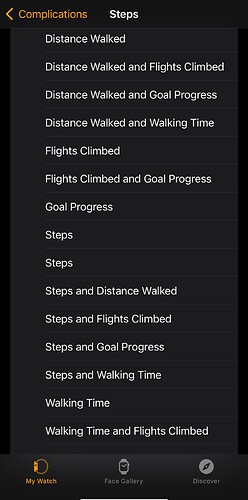Yeah, the Newsweek article I linked to says something similar. Idk whether there’s something special about walking compared to doing similar amounts of other aerobic exercises like swimming, running, and bicycling, but walking has the advantage of being cheap, easy to start and maintain pretty much anywhere you happen to be, and having a very low risk of injury.
Thanks for the good wishes.
Unless one is walking through local woods where there are exposed tree roots, paths with shifting camber, uneven ground, and said ground muddy. The combination that caused me to twist my knee.
Still less risky, comparatively, than running or mountain biking through the woods…
And poisonous snakes, grizzlies, and quicksand. ![]()
Hope that heals up quickly for you. I’ve had knee issues, too, and they’re no fun.
You could try Steps https://apps.apple.com/gb/app/steps-activity-tracker/id708359518
It has widgets for the iphone and the watch. It is only a couple of quid to get rid of the ads
This is the list of watch complications you can use
I love David _Smith’s “Pedometer++”. As you’d expect from the developer of widgetsmith and watchsmith it has every widget and complication you could ever want and it’s reliable and fuss-free. You can tell it’s written by a serious walker, for himself.
I pay the subscription because it’s worth it for me but the free version is the best simple pedometer I have ever used.
OP specifically mentioned trying and rejecting Pedometer++
Here’s the thing though, the Step count provided doesn’t match the data in Health and doesn’t put the data into Health.
Some days it’s a thousand steps more than Health and other days it’s 600 steps less than Health.
I don’t like the inconsistency, so I choose to go with the default.
I recently read some articles that mentioned 8,800 steps per day.
One article linked to this scientific research.
Pedometer++ uses the phones gyroscope to calculate the steps rather than the watch which is why there’s a mismatch.
That scientific research made me chuckle when the authors referred to “an optimal dose at 8,763”.
Will try for patient access to the complete paper but definitely not going to use their paywall. (Although Google Scholar got me closer.)
The watch is likely more accurate because it’s always worn on your wrist and your arms usually swing in time with your steps. A phone can be carried in pants pockets, jacket pockets, a bag, etc.
Without a doubt the watch will be more accurate, I was stating why they might be / are different is all ![]()
Yes, I understood your your comment and it was excellent! It added important information to the conversation and got me thinking about which one would be more accurate.
OTOH, what if your watch hand is holding/carrying something and not swinging? You can walk without swinging your arm, but unlikely to do so while not moving your legs. So in some ways a phone could be more accurate.
My phone and watch seem to co-mingle data and theoretically produce a combined more accurate output. Having said that, while my wife has a different stride and our steps do not match, we still cover the exact same distance when on our morning walk but our distance measured is normally off by a significant amount. Would be nice to have more accurate counts of both steps and distance.
There is also an option on Pedometer ++ to collect both the Phone and Watch and amalgamate the data, but I was never reassured by either result.
Apple Health will also collect data from the watch and the phone e.g. My wife doesn’t have an Apple Watch (She’s a Nurse and they’re not allowed to wear “jewellery” but the phone still counts her steps.
In the official docs, Apple recommends trying to keep your watch hand free to get the most accurate exercise readings. The example they give is to hold the leash in your opposite hand when you’re walking a dog so your watch hand can swing freely.
From my experience and anecdotal evidence, I happily admit I could be wrong…
If P++ doesn’t detect steps and the watch does it will add it, but it doesn’t let health override the whole amount.
Health only uses the phone data if you don’t have an apple watch, if you do and don’t wear it then it doesn’t calculate any health data.
It’s important to keep Apple Health measurements in perspective. Even if the sensors are all excellent all the time, the specific conditions in which they are working can be very easily compromised, even from moment to moment.
If we tend to use our devices in the same way more or less every day, the sheer amount of data gathered means that the trends in the data may well be valid and provide enough precision to be useful. Any specific metric (e.g. how many steps I took today) is very unlikely to be accurate. You don’t even know, unless you have an accurate, independent means of making the same measurements at the same time in the same conditions, how accurate any measurement is.
By all means choose the data you wish to monitor, and it’s probably a good idea to stick with one app and means of measuring anything that’s important to you, but variation between measurements is a fact of life.
